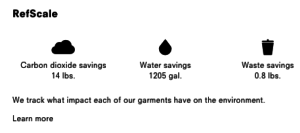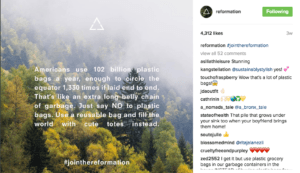THE REFORMATION OF THE FASHION INDUSTRY

The Reformation of the Fashion Industry

Clothes and…Climate Change?
Who thinks about the impact of their clothes on our climate when they get dressed in the morning? Not many people, it seems. Everyone talks about the impact that the oil, auto, and agriculture industries have on climate change, but the fashion business has managed to keep a low profile – until recently.
The garment industry contributes 10% of worldwide carbon emissions, is a top three industrial polluter, and the second largest polluter and user of water [1,2]. The rise of “fast fashion” has exacerbated the problem, producing 4x more carbon emissions than standard fashion [1,2]. The crimes of the business extend throughout the value chain, from raw materials like cotton and synthetic textiles, to manufacturing, shipping, washing and dry cleaning, all the way through the disposal of excess fabric and old clothes.
Raw Materials & Textiles
Cotton, the largest raw material in clothing, is the largest user of pesticides in the world and making a t-shirt can require nearly 700 gallons of water to produce [2,3]. Synthetic fibers like polyester are worse, emitting volatile organic compounds such as nitrous oxide, which is an exponentially more powerful greenhouse gas than CO2 [2,3].
Manufacturing, Transportation & Shipping
Manufacturing processes and transportation (98% of clothing in the US is imported) emit greenhouse gasses and consume large amounts of water [3].
Clothing Care & Disposal
A substantial amount of the environmental impact of clothing comes after the purchase, through the use of washing machines, dryers, and the disposal of recyclable garments into landfills [3].
Victim of Its Own Crimes
The industry isn’t just a contributor to global climate change, but a victim of it. Droughts and unpredictable temperatures caused by climate change have hurt cotton yields, raising prices [4]. Unseasonably warm temperatures have impacted retailers’ ability to predict demand for cold-weather items like outerwear. Similarly, consumers’ willingness to buy clothes months ahead for the next season, as in the traditional fashion model, has waned [4]. Finally, traditional brands face increasing competition for socially-conscious millenials’ share of wallet from eco-friendly brands like Zady, Everlane, and others [4].
An Eco-Friendly Model
Enter the Reformation, a venture-backed, e-commerce focused fashion company for millennial women. Since its launch in 2009, the Reformation has become the “it-girl” brand, worn by celebrities like Taylor Swift, Karlie Kloss, and Lily Aldrige, all the while maintaining a vocal commitment to sustainable and ethical fashion.
Founder Yael Aflalo was inspired to create the brand after a visit to a Chinese manufacturing town left her floored:
“ ‘The smog was so thick that I couldn’t see beyond one city block…I understood for the first time, in a very real way, the connection between fashion and the environment. The clothes that filled my closet were responsible for this horrible pollution.’” [5]
After some extensive research, she launched the brand with the motto “We make killer clothes that don’t kill the environment” [1].
Reformation’s commitment to sustainability extends to every single part of its business, from material sourcing and supply chain, into every nook and cranny of its offices and stores.
Textiles, Manufacturing and Shipping
Reformation’s fabrics have a much smaller ecological footprint than their traditional counterparts. They use 40% vintage and deadstock fabrics, substantially reducing carbon emissions. They also use eco-friendly fibers like Tencel which is made from Eucalytpus trees and uses 80% less water than cotton. They source 50% of materials domestically, thus reducing emissions versus importing from Asia. They have even developed a carbon neutral shipping program in the U.S. [3].
Clothing Care and Recycling
Reformation focuses on sustainability long after the initial purchase. They recycle all textile scrap when possible, and offer prepaid shipping labels to customers to recycle their old clothes [3].
Corporate Practices
At Reformation HQ and retail locations, they use wind power, LED lighting, Energy-Star rated appliances, reclaimed furniture, and recycleable and biodegradable office supplies [3].
Another key part of their revolutionary business model is consumer education. The website is filled with information about the impact of fashion on the environment, how to wash clothes sustainably, and each garment on the website is rated on the “RefScale”, measuring its water use and CO2 emissions [3].



Reformation also leverages its strong social media presence to drive the message home with bite-sized pieces of information on sustainability against an attractive backdrop.


An Even More Sustainable Future
Reformation has made great strides, but major retailers and brands will need to step up to the plate to make a meaningful impact on carbon emissions. To that end, Reformation should continue focusing on to driving awareness about the ecological impacts of fashion through its use of social media. This will drive more people to purchase Reformation products, but will also cause more consumers to demand eco-friendly fashion from its larger competitors. In this way, practice changes by the mass brands and retailers will ultimately be driven from the bottom up.
792 Words
Sources:
[1] Ana Andjelic, “Fashion brands, long focused on excess, are finally waking up to sustainability. Can eco-friendly startups shift industry values?,” AdWeek, May 20, 2016, http://www.adweek.com/news/advertising-branding/fashion-brands-long-focused-excess-are-finally-waking-sustainability-171609, accessed November 2016.
[2] James Conca, “Making Climate Change Fashionable – The Garment Industry Takes on Global Warming,” Forbes, December 3, 2015, http://www.forbes.com/sites/jamesconca/2015/12/03/making-climate-change-fashionable-the-garment-industry-takes-on-global-warming/#331dc4ee778a, accessed November 2016.
[3] The Reformation, “Who We Are”, https://www.thereformation.com/whoweare, accessed November 2016.
[4] Arthur Zaczkiewicz, “Is Climate Change Killing the Seasonality of Fashion Apparel Retailing?” WWD, October 18, 2016, http://wwd.com/business-news/business-features/climate-change-impact-fashion-apparel-10525390/, accessed November 2016.
[5] Yael Aflalo, “What Happened When I Realized My Cheap Clothes Were a Global Problem,” Motto (Time), March 28, 2016, http://motto.time.com/4264392/sustainable-clothing-reformation/, accessed November 2016.



I’m also a huge fan of the brand! However, I think more can be done to further their mission towards sustainability. I found it surprising that they offered free shipping + returns despite how bad that is for the environment. In addition, while they purchase unused fabrics – it was unclear to me whether these fabrics are easily decomposed or recycled after use. Thanks for the post!
It’s interesting reading this post in parallel to posts about H&M’s sustainability efforts. It seems like Reformation is one step farther along the line than H&M since it uses vintage fabrics and has a recycling program. Including customer education as part of its brand also differentiates it from H&M and many other fashion companies. I would be interested to hear in more detail what the “carbon neutral shipping program” in the US actually entails, especially given Gabrielle’s comment above.
Really great post! I didn’t realize there was a company out there that was already tracking its environmental impact and sharing it with its consumers. I wonder where the “industry standard” data comes from? I also wonder if they will institute some sort of continuous improvement model to show their customers that they are continuing to make improvements on all of these statistics. It was really interesting to think about how the fast fashion concept has changed the frequency with which people buy and dispose of clothing. I wonder if it is possible to shift back to “investing in staples” mentality in order to have a positive impact on the environment.
Just like our IKEA cases, sustainability is one of the core areas of concern for many manufacturing based companies. The most difficult action item from the potential solutions from my perspective is actually educating the consumers. Fundamentally, consumers are inclined to pay only for the value that they are getting for. Consequently, it would be extremely difficult to persuade the general public to pay for damages that the supplier has caused. Also, advocating for environment and expecting consumers to bear the cost would not go well especially consumers in developing countries where economic stability is not achieved at a country level. As a result, it is one of the most interesting topics to follow on how they roll out changing the fundamental perspective of consumers alike.
I love this brand! Yet, I actually had no idea that they use 40% vintage and deadstock fabric, eco-friendly fibers, and 50% domestically-sourced materials. They could do a better job of communicating this message!
I would love to see a brand like this really take off. However, is this business model scalable? Will they be able to continue sourcing 40% vintage and deadstock fabrics if they continue to grow?
I think it’s great they have managed to develop a carbon neutral shipping program in the U.S. I wonder if they use only recyclable shipping and product packaging materials?